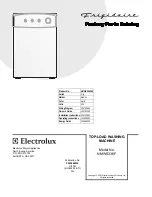
EN
6
Anti-condensation strip
*
After installing the dishwasher, open the door and stick the
adhesive transparent strip under the wooden shelf in order
to protect it from any condensation which may form.
Advice regarding the first wash cycle
After the installation, remove the stoppers from the racks and the
retaining elastic elements from the upper rack, if any.
Immediately before the fist washing,
completely fill the salt
dispenser with water and add only then approximately 1
kg of salt
(see chapter entitled Rinse aid and refined salt)
.
The water may overflow: this is normal and is not a cause
for concern. Select the water hardness value
(see chapter
entitled Rinse aid and refined salt).
- After the salt has been
poured into the machine, the LOW SALT indicator light
*
switches off.
If the salt container is not filled, the water softener and
the heating element may be damaged as a result.
Technical data
Dimensions
width 44,5 cm
height 82 cm
depth 55 cm
Capacity
10 standard place-settings
Water supply pressure
0,05 ÷ 1MPa (0.5 ÷ 10 bar)
7,25 – 145 psi
Power supply voltage
See appliance data plate
Total absorbed power
See appliance data plate
Fuse
See appliance data plate
This dishwasher conforms to the
following European Community
Directives:
-2006/95/EC (Low Voltage)
-2004/108/EC (Electromagnetic
Compatibility)
-2009/125/EC (Comm. Reg.
1016/2010) (Ecodesign)
-97/17/EC (Labelling)
-2012/19/EU
Waste Electrical
and Electronic Equipment
(WEEE)
The machine has a buzzer/set of tones
(depending on the
dishwasher model
)
to inform the user that a command has
been implemented: power on, cycle end etc.
The symbols/indicator lights/LEDs on the control panel/
display may vary in colour and may have a flashing or fixed
light
(depending on the dishwasher model)
.
The display
*
provides useful information concerning the
type of wash cycle, drying/wash-cycle phase, remaining
time, temperature etc etc.
ECODESIGN REGULATION
ECO wash cycle is the standard cycle to which the energy label data refers; this cycle can be used to wash crockery with a nor-
mal soil level and is the most efficient in terms of energy and water consumption for this type of crockery. To reduce consumption
even further, only run the dishwasher when it is full.
Standby consumption: Left-on mode consumption: 3 W – Off mode consumption: 1,3 W
Consumption data table for the main cycles
*
Cycle data refers to the values recorded in a laboratory, in accordance with European standard EN 50242.
**
Data is obtained by recording values when the appliance is operational and loaded with user crockery.
Standard conditions
*
User conditions
**
Energy consumption
(kWh/cycle)
Water consumption
(l/cycle)
Duration
(min/cycle)
Energy consumption
(kWh/cycle)
Water consumption
(l/cycle)
Duration (min/
cycle)
INTENSIVE
1,30
14
150
1,15
14
140
NORMAL
1,05
14
115
0,95
13
110







































